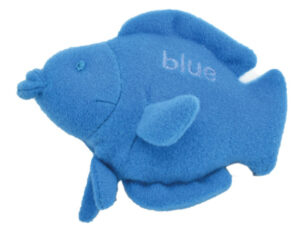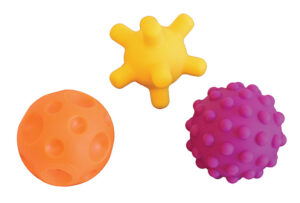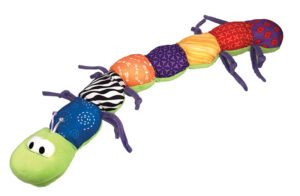Object inquiry skills
A young infant watches a toy fish manipulated by a caregiver.




 Place an infant who is not yet crawling in a comfortable, secure, reclining position across from you or on the floor. Show the toy fish to the infant when he/she is alert. Hold the toy about 12–15 inches from the infant’s face. Softly say the infant’s name and the name of the toy. Example: “Sarah, we have a toy fish. Our fish has pretty colors. You can watch our fish.” Keep the toy still so the infant can focus his/her eyes. When the infant focuses visual attention on the little fish, slowly move it in a horizontal movement across his/her visual field. The infant may move his/her head and eyes in order to follow the toy. Describe the fish’s movement and the infant’s actions. Example: “Here is our toy fish. You are watching the fish with your eyes.” Use a soft voice to acknowledge the infant’s efforts. Example: “You are watching the toy fish move.”
Place an infant who is not yet crawling in a comfortable, secure, reclining position across from you or on the floor. Show the toy fish to the infant when he/she is alert. Hold the toy about 12–15 inches from the infant’s face. Softly say the infant’s name and the name of the toy. Example: “Sarah, we have a toy fish. Our fish has pretty colors. You can watch our fish.” Keep the toy still so the infant can focus his/her eyes. When the infant focuses visual attention on the little fish, slowly move it in a horizontal movement across his/her visual field. The infant may move his/her head and eyes in order to follow the toy. Describe the fish’s movement and the infant’s actions. Example: “Here is our toy fish. You are watching the fish with your eyes.” Use a soft voice to acknowledge the infant’s efforts. Example: “You are watching the toy fish move.”
This will be a brief yet important experience for the infant. Visually following a toy that moves in different directions requires effort. Allow ample time for the infant to focus on the toy fish before moving it. Repeating the activity will be satisfying for most young infants, but a brief break may be appropriate. Be sure to move the toy slowly and avoid quickly changing direction. Offer the toy to the infant if he/she reaches out to grasp it.
Extra support
Enrichment
Object inquiry skills
An older infant explores three different types of balls.



 Place the balls in a container. Invite an infant who can sit with support or independently to play with you and some balls. Place the container with balls in front of the infant. Sit across from the infant. Point to each of the balls in the container as you say something about the texture or shape of each. Example: “This ball has little holes. This ball has bumpy things. This ball has things sticking out of it.” Pointing to characteristics of each ball (without picking up a ball) is important because the infant may not understand most of your words.
Place the balls in a container. Invite an infant who can sit with support or independently to play with you and some balls. Place the container with balls in front of the infant. Sit across from the infant. Point to each of the balls in the container as you say something about the texture or shape of each. Example: “This ball has little holes. This ball has bumpy things. This ball has things sticking out of it.” Pointing to characteristics of each ball (without picking up a ball) is important because the infant may not understand most of your words.
Provide time for the infant to look at the collection of balls. Then encourage the infant to pick up and feel a ball if he/she has not done so already. Describe the infant’s actions with a ball(s). Mention a characteristic of a ball if the characteristic seems to be of interest to the infant. Example: “You are feeling the bumps on the ball.” Bring the activity to a close when he/she no longer shows interest.
There are likely to be differences across infants in how they participate in the activity. An infant may not focus on the shape or texture of a ball as intended in the activity description. Some infants may be interested in removing all of the balls, whereas others may focus on only one. Some infants may want to roll a ball, hand a ball to you, or move balls out of, and then back into, the container. An infant may use his/her mouth to explore a ball. Follow the infant’s lead in exploring the balls. Describe the infant’s actions and draw attention to characteristics of a ball without directing the exploration. If the infant hands a ball to you, thank the infant and then pass it back. Most infants will use two hands to hold and manipulate a ball.
Extra support
Enrichment
Object inquiry skills
Infants participate in guided exploration of a toy inchworm.



Be Prepared: Limit the number of participants to available toys. It is important for each infant to have a toy inchworm for this activity.
[Invite several infants to sit with you on the floor. Give each infant a toy inchworm.]
Here is a toy for us to play with. This toy is called an inchworm. An inchworm is an animal. Let’s find out about our toy.
 Our toy has eyes. Do you see the inchworm’s eyes?
Our toy has eyes. Do you see the inchworm’s eyes?
[Point to the toy’s eyes.]
Do you see the eyes? We can touch the eyes of our toy.
[Encourage infants to touch or point to the eyes of the toy. Then encourage infants to point to their own eyes. Demonstrate by pointing to your own eyes.]
We have eyes, too! Let’s all point to our eyes.
We look at things with our eyes. We are looking at each other. We are looking at our toy!
Our toy is soft. Would you like to feel our toy?
[Demonstrate touching the toy. Then demonstrate squeezing the toy with both of your hands.]
I am squeezing the toy. I am using both of my hands to squeeze the toy. You can squeeze your toy, too!
[Encourage infants to squeeze their toy. Then point to your ear as you draw attention to hearing the toy make a noise.]
Did you hear our toy make a noise? We heard a sound when we squeezed our toy!
[Describe infants’ actions and reactions. Example: “Devon, your toy squeaked! You squeezed your toy and it made a noise!”
Encourage repeated squeezing of the toy and talk about how squeezing can make the toy make a noise.
Then demonstrate squeezing the crinkle section of the toy. Draw attention to your action and the part of the toy that makes a crinkle noise. Example: “We can hear a quiet crinkle sound.”
Encourage repeated squeezing of the crinkle section and talk about how squeezing this part of the toy makes a crinkle noise.
Then gently shake the toy. Draw attention to the rattle sound when the toy is shaken.
If infants remain interested in the toy, invite them to move their toy on the floor. Make up a pretend destination or reason for moving the toy. Example: “Our toy is a little animal. Our toy wants to meet another toy! Let’s pretend our toys are moving on the floor to meet each other.”]
[Say and demonstrate each of the actions used with the toy during the session. Example: “We played with a fun toy. We felt our toy. We squeezed our toy. We shook our toy. We listened to our toy!”]
The toy used in this activity is pleasing for most infants to touch and manipulate. The size and shape are novel. The toy is soft and easy to hold. The sounds an infant can make with the toy are also appealing. Look for opportunities to draw attention to cause-effect connections when sounds are made with the toy. We squeeze the toy. The toy makes a sound. Also look for opportunities to point out the sections (bumps) of the toy. This feature of the toy is not explicitly addressed in the activity description, but infants may notice the colorful sections on their own. Emphasize how we can move our hands along the toy to feel its parts.
The word inchworm is introduced in the suggested opening segment of the activity, but infants are not expected to learn or say this word. The activity plan’s suggested talk with infants does not use the word after introducing it.
Extra support
Enrichment
Materials needed: rattles, small balls with textures, stacking cups, loose stacking rings in a bowl, soft texture bears, books with textures (such as Baby Touch and Feel by DK Publishing), toys with holes (such as a whiffle ball), and books with holes (such as Little Puppy Finger Puppet Book by Chronical Books, LLC.)
Provide a small collection of rattles and small balls with texture for non-mobile infants to explore. On another day, provide stacking cups, loose stacking rings in a bowl, soft texture bears, and books with textures (such as Baby Touch and Feel Puppies and Kittens by DK Publishing). For mobile infants, arrange loose items to dump and fill in stacking cups. Also, offer a small grouping of toys with holes, such as a whiffle ball, and books with holes.
Materials needed: balls of different sizes, basket or non-breakable container
The Option 2 activity may prompt toddlers and preschool-age children to also want to play with balls. Toddlers may be interested in rolling balls of different sizes. For preschool-age children, set up a target using a basket or non-breakable containers and encourage children to gently toss balls into a container.